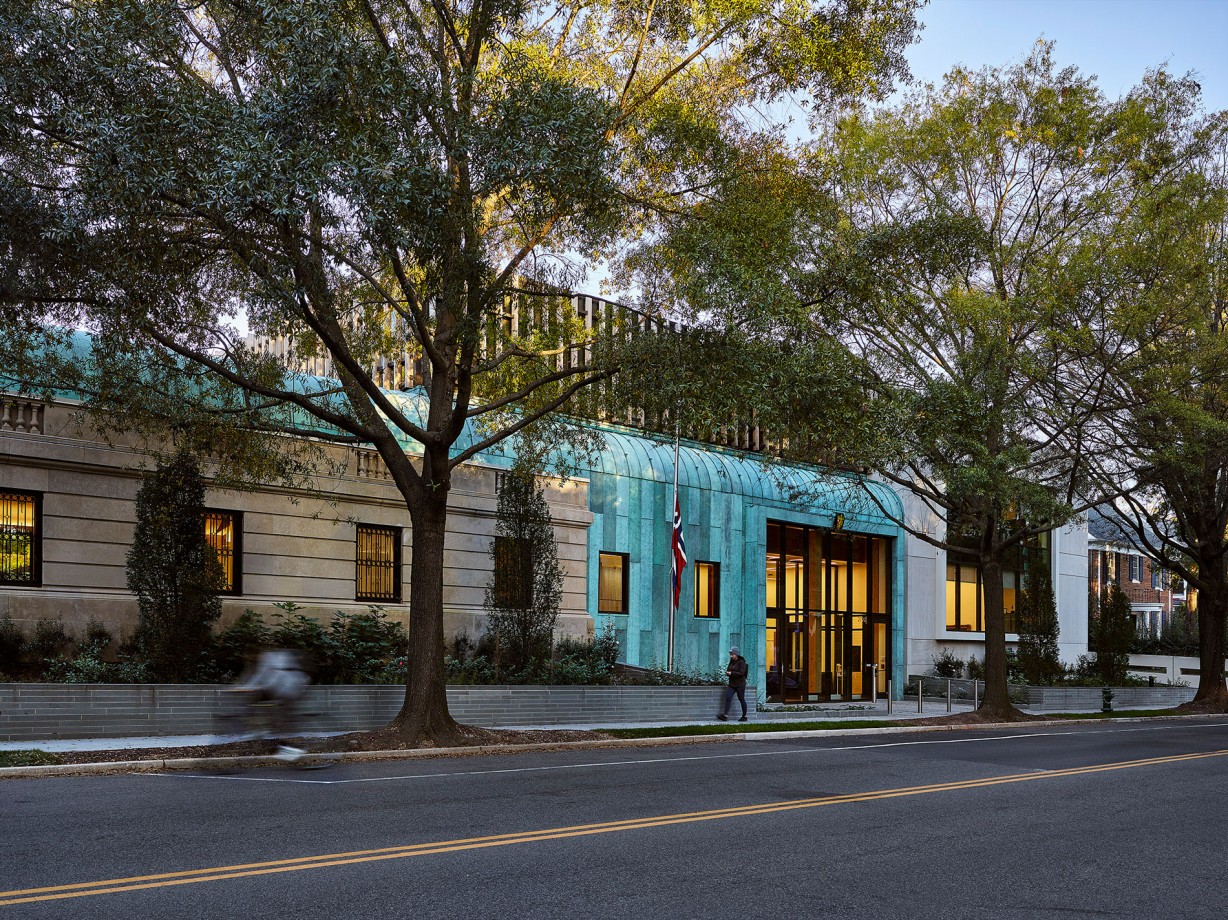Market: Museums + Culture
National Museum of the Marine Corps
Denver Art Museum: Martin Building Renovation + Sie Welcome Center
Royal Norwegian Embassy Opens New Chancery to the Public
Fentress’ first-ever embassy project reinforces Norway’s diplomatic bond with the United States, and advances the Embassy’s mission for world peace, fairness and sustainability.
Established in 1905, Norway’s Embassy is located on the venerable Embassy Row in Washington, DC. It resides between the Vice President’s residence and the National Cathedral. Its 1970-era Chancery recently underwent an 30,000-square-foot expansion and renovation. Fentress Architects designed this essential element of Norway’s largest embassy complex in to be culturally symbolic. Additionally, the embassy is architecturally harmonious, modernized, sustainable and universally accessible.
Architecture can play a profound role in the diplomatic environment. Therefore, every element of the project was carefully considered for staff, guests, and diplomatic relations alike. Four principles guided this effort: Handlekraft (vigor), Arbeidsglede (joy of work), Profesjonalitet (professionalism) and Åpenhet (openness).
“While providing significant functional, accessibility and sustainability upgrades, our architecture makes Norway’s rich heritage visible on one of the most culturally significant streets in the world.”
— Steve White, Principal & Director of the Washington DC Office, Fentress Architects
ARCHITECTURAL DESIGN
The transformed Chancery is comprised of three elements: a stone shell, a cocoon, and a copper-clad mass timber hull. The mass and forms of the limestone-clad stone shell are deliberately segmented and scaled to show deference to the Ambassador’s residence. They blend harmoniously with the historic residential neighborhood. While the vast majority of the existing structure and limestone cladding were retained and restored, strategic interventions were made to the stone façade. They now open up new views of the garden and public street, block undesired views from neighbors, and introduce generous daylight within.
The wood-finned curtainwall cocoon wraps internal elements including the lobby atrium and Social Hub. It also extrudes externally to screen rooftop elements. An open stair connects a two-story space known as the “Social Hub.” This hub functions as a venue for staff to engage in intellectual dialogue and build community.
A copper-clad mass timber hull helps to demarcate and celebrate diplomatic spaces. Wrapped in copper, an open, gracious and accessible new entry to the Embassy results from lowering the original lobby structure seven feet and eliminating an associated obtrusive staircase. Copper cladding recalls Norway’s gift of copper for the Statue of Liberty. Adjacent to the entry is Atlantic Ocean Hall. This hall incorporates the old garden wall and captured underutilized courtyard space. Atlantic Ocean features a new mass timber structure that recalls Viking mastery of shipbuilding and woodworking. In rhythm with the historic windows, the structure’s spruce columns alternate in a triangular grid. This eliminates the need for additional cross bracing and creates a dramatic, yet intimate space for Norwegian hospitality and diplomacy. The mansard form of the roof is appropriate to the neighborhood and gives the Atlantic Ocean Hall its distinctive shape.
SUSTAINABILITY: REUSE
Given that sustainability is a tenet of the Embassy’s mission, it was also a tenet of the design. Reusing existing buildings is inherently more sustainable than new construction. Accordingly, we reused 90-percent of the existing structure with only 3,500 square feet added. Interventions focused on increasing program area within the existing footprint, enhancing the indoor and outdoor environment, and improving systems performance.
For example, previously underutilized areas are now flexible, multi-use rooms. Likewise, a spacious staff lunchroom can accomodate large informal meetings. It also provides food-prep support to Atlantic Ocean Hall and Courtyard functions. Smaller, multi-use spaces exist throughout both office wings. Flex spaces such as these, along with open office layouts, more easily accommodate future needs. In fact, all office spaces were completely reconfigured and improved. Likewise, a cold, dark, north-facing courtyard terrace between the two office wings was glazed-in. It now features a social gathering space and coffee bar.
Bioswales that harvest rainwater from roofs and gardens now flank the entry plaza. These bioswales feature native, pollinator-friendly garden species. Atlantic Ocean Hall opens out onto a large, terraced garden. The garden features structured turf for tented events, a rain garden with native species, flowering perennials, mature trees, and a semi-private Ambassador’s Walk. Additional sustainable strategies included:
- Almost half the site is open space, planted with native and adaptive, pollinator-friendly species. All parking is underground, with electric charging stations for cars and bicycles. All street trees, which are also mature and considered heritage, were retained.
- Bioretention planters and permeable pavements manage all the run-off on-site, eliminating any burden to the Rock Creek watershed. Indoor water use is 25% less than baseline.
- Thermal envelope upgrades, new low-e double-glazing, and fritted skylights result in a projected energy cost savings of 21.8-percent over the ASHRAE-90.1 baseline.
- The wood and copper structures highlight natural materials and promote traditional skills and craftsmanship. These may also be disassembled, reused and recycled.
- Sustainably harvested wood made up 2.5-percent of the total value of architectural construction material.
[Atlantic Ocean Hall, a] year-round, indoor-outdoor space has already hosted climate-focused presentations and events, and turns diplomats and visitors into tree huggers.
— Arild Ravlo Hersleth, Project Manager, Statsbygg
ART
Standby power, durable technology infrastructure, and a robust building enclosure system are among the many elements that reinforce structural resilience within the Chancery. In addition to being amply secure, the Chancery also features an accessible and transparent street presence. An internal elevator connects all levels. Restrooms are gender neutral. Textured stair landings assist the vision-impaired.
New and repurposed art pieces included further enliven the spaces. Metamorphosis—a significant larvikite granite sculpture by Knut Steen (1986)—was relocated to the garden. The building also features five new, specially-commissioned major installations. One of these is the 18-foot long Dreams Ahead, by Ann Cathrin November Høibo. This hangs in the lobby atrium space and is visible from the public right of way along 34th Street.
In April 2022 the Embassy Renovation Project won its first award from the Washington, DC Chapter of the AIA.
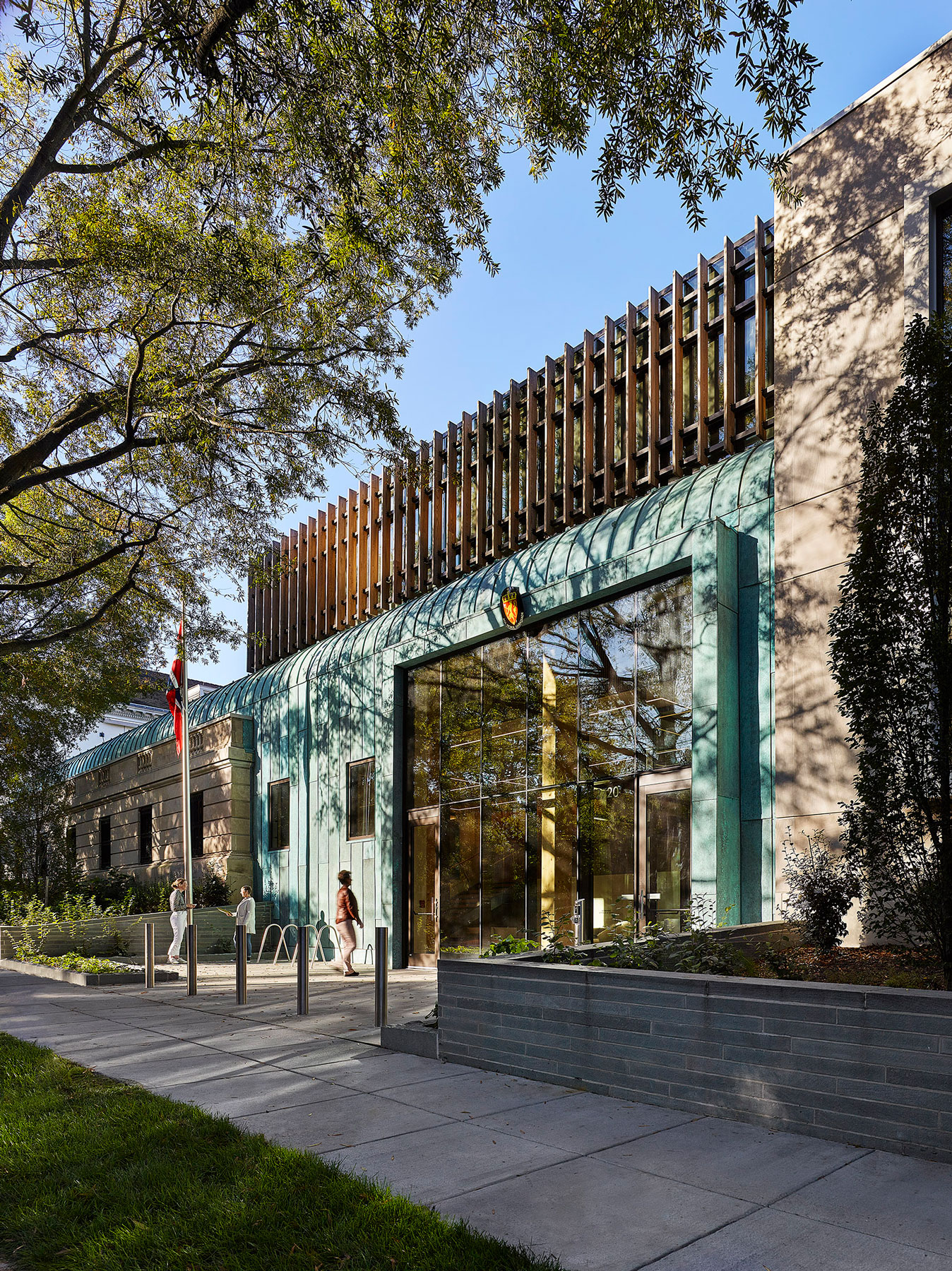
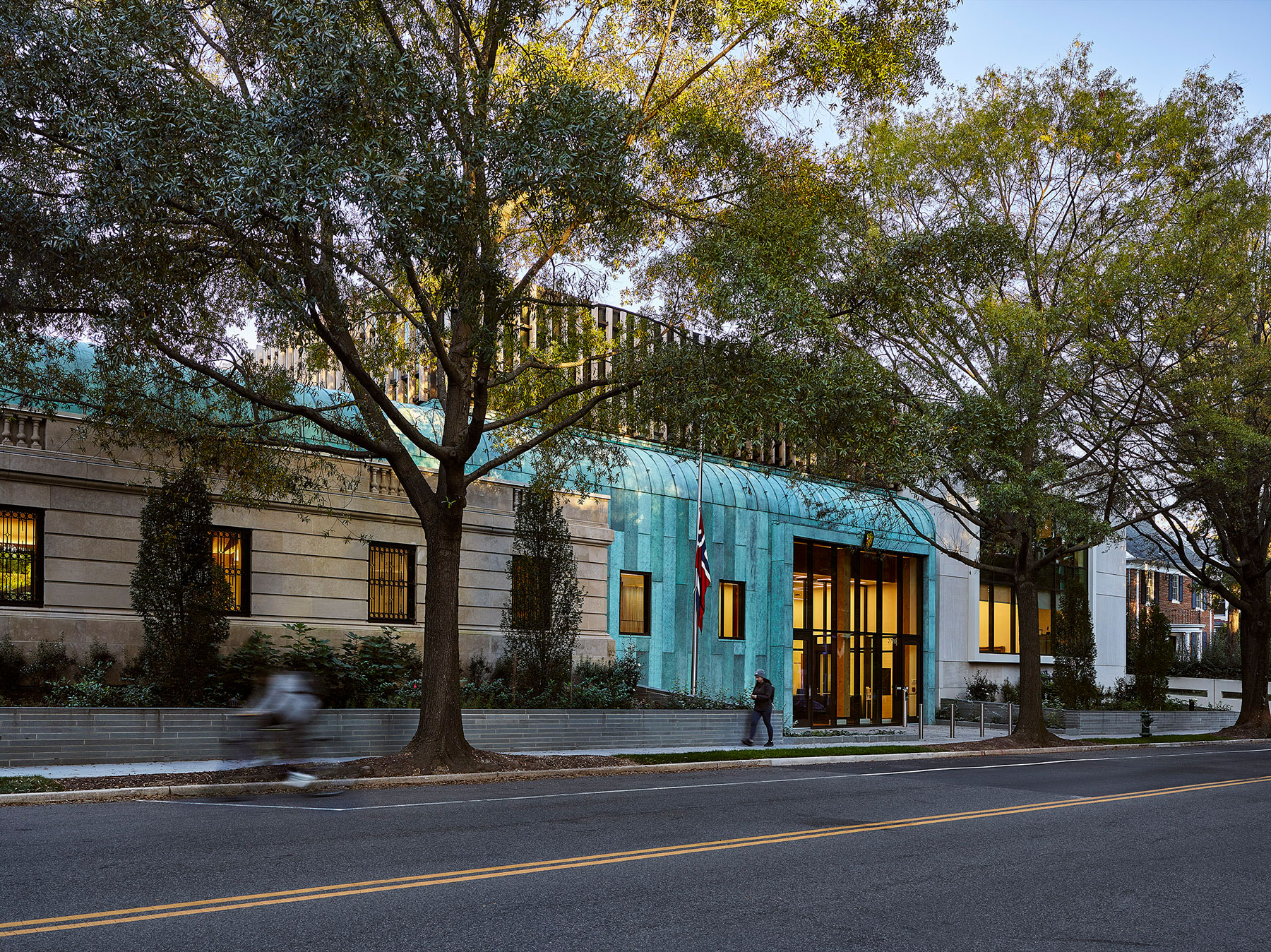
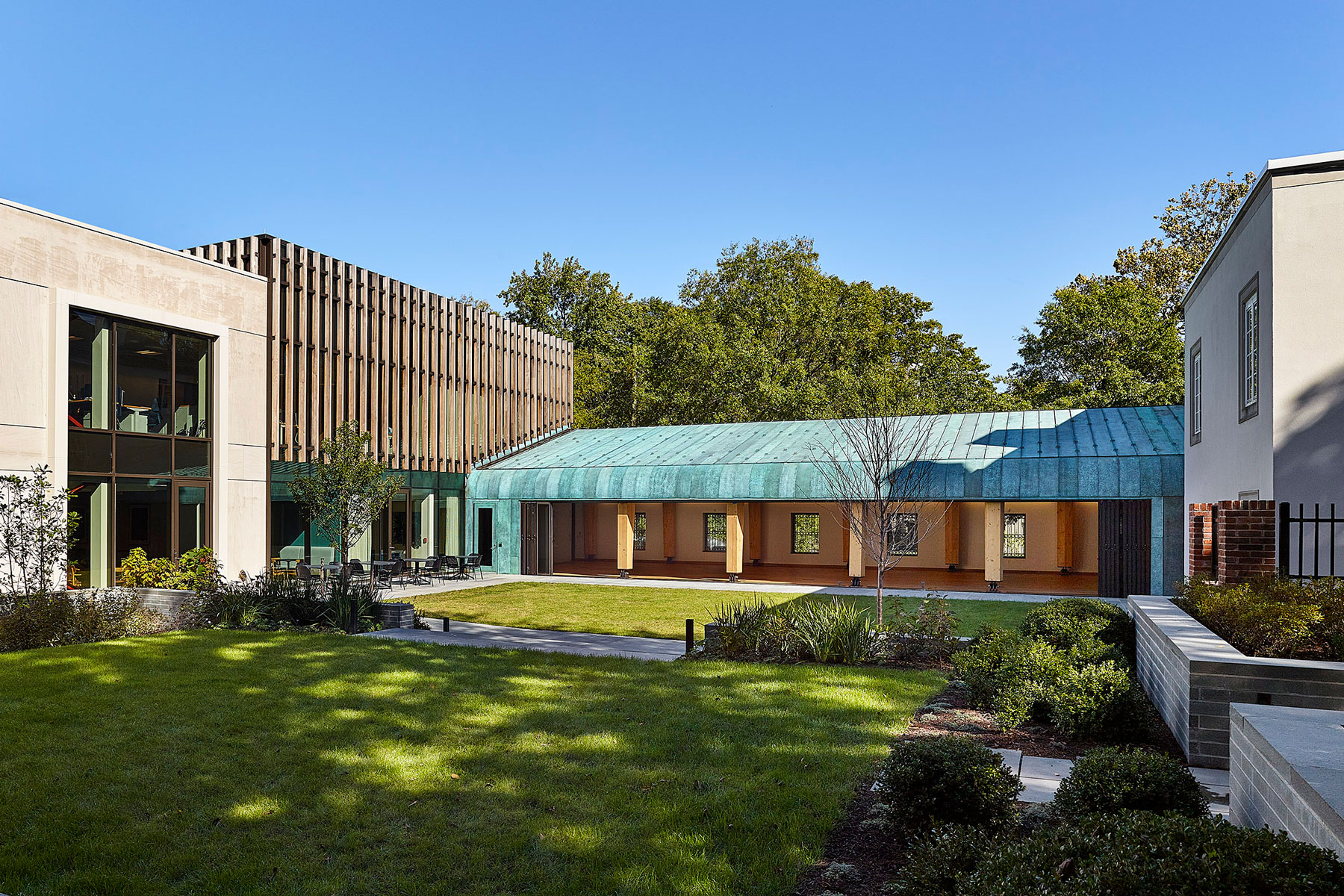
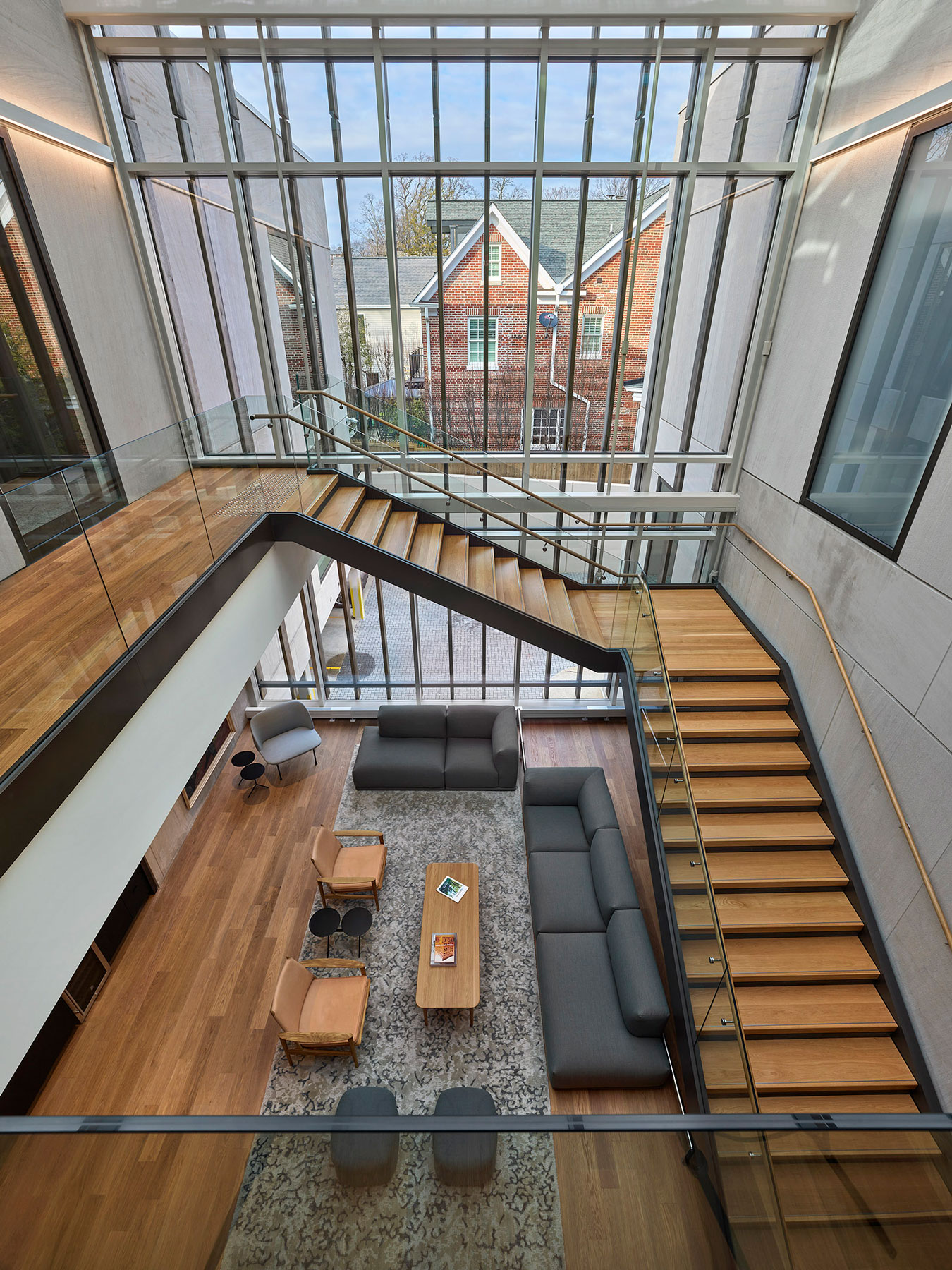
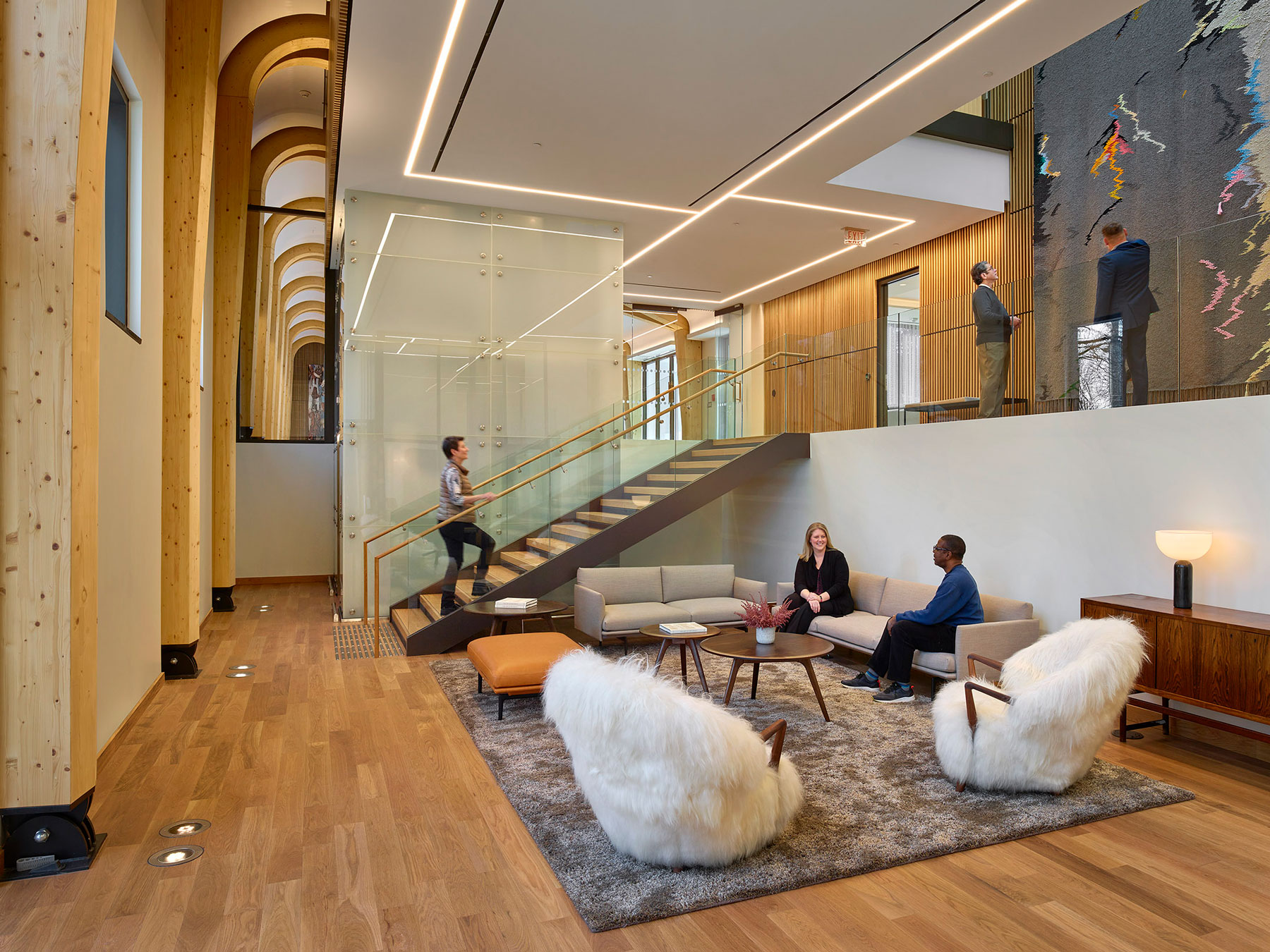
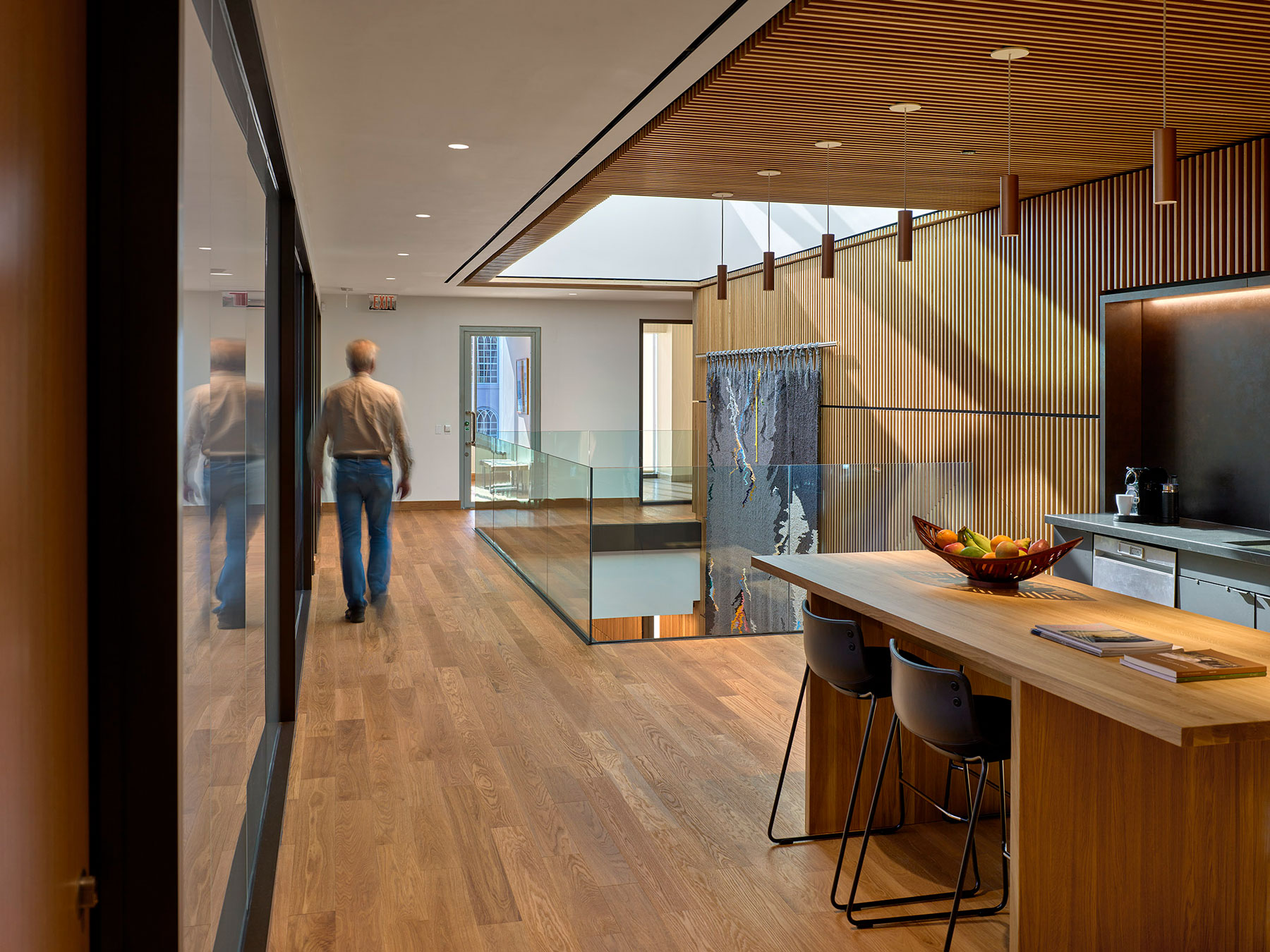
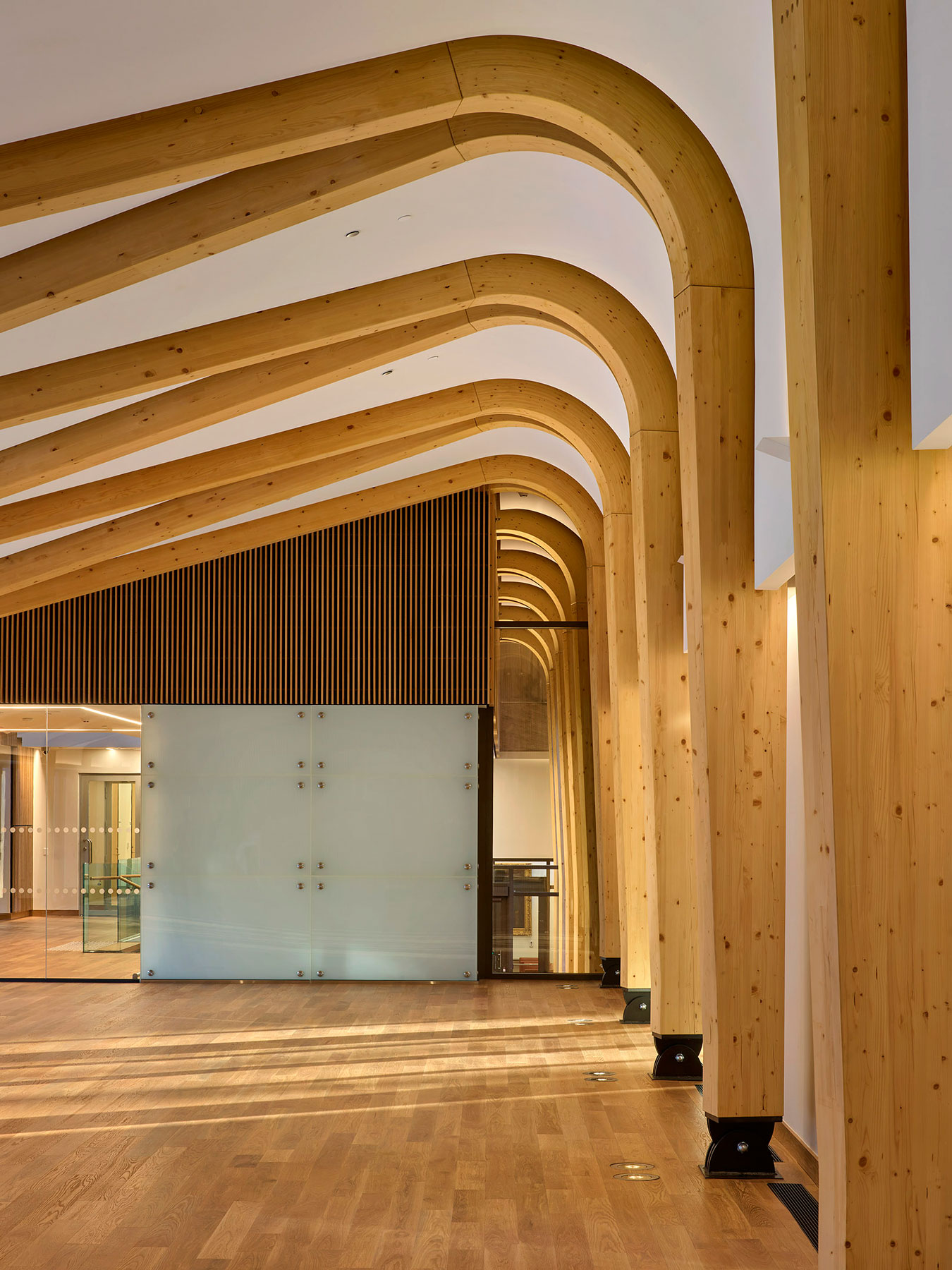

ABOUT THE EMBASSY
- With a staff of 60, the Embassy in Washington is Norway’s largest.
- The original chancery was built in 1977 as a two-story, limestone-clad structure. It contained basement parking, staff offices and diplomat apartments.
- The first structure built on the Embassy grounds was an historic Italianate residence for the ambassador. Completed in 1931, this was also the second foreign service mission to be constructed in the United States on the venerable Embassy Row on Massachusetts Avenue. It is a beautifully articulated expression of early 20th century neo-classical architecture. The Italianate structure features a symmetrical tripartite arrangement: rusticated base, piano Nobile and hipped roof. Its Indiana-limestone façade includes quoining and an ornamental bracketed cornice. Piano Nobile fenestration consists of pedimented limestone openings with Juliette balcony balustrade. The slate roof is hipped and symmetrical with the façade. Extending from the house to the north, as part of the 34th Street experience, is a rusticated one-story limestone garden wall, which encloses a beautifully manicured landscape.
Fentress Architects Selected for the California Indian Heritage Center
CIHC will honor the rich heritage, traditions and cultures of the first peoples of California
SACRAMENTO, CA—California State Parks and the California Indian Heritage Center Task Force today announced Fentress Architects as the firm to design the long-desired build out of the California Indian Heritage Center (CIHC). Once complete, visitors from across California, the nation, and the world will be drawn to this center of statewide significance. It will be a home for cultural preservation, learning and exchange, land stewardship based on Native American values, and a place to engage all visitors celebrating the living cultures of California tribal communities.
The 51-acre CIHC site is located at the confluence of the American and Sacramento Rivers in West Sacramento. The project constitutes a decades-long collaboration and demonstrates the state’s commitment to and responsibility for partnering with California Native American tribal governments and communities along with allied individuals and institutions to develop the site. CIHC’s design and development began in earnest with the commitment in the State’s 2018-2019 budget to invest $100 million in state funds. An additional $100 million was authorized in the budget for the phased buildout via private and philanthropic support. In December 2018, the Governor’s Office issued Executive Order B-60-18. This order directed the Tribal Advisor to establish a task force that would oversee the development of the CIHC. The Tribal Advisor established a CIHC Task Force of California Native American tribal and community leaders in 2019 to inform and lead the project until its completion.
In the next few months, the CIHC Task Force, California State Parks and Fentress Architects will kick off a public engagement process, including extensive tribal outreach. Members of the public and tribal communities who would like to be notified of upcoming events and/or receive information on how they can get involved with the project are invited to contact State Parks via email at CaliforniaIndian.HeritageCenter@parks.ca.gov or by visiting the project website at parks.ca.gov/CIHC. The project is anticipated to open to the public in 2028.
Fentress Architects was chosen out of 22 firms who submitted a Statement of Qualifications (SOQ) for the project. The CIHC Task Force and California State Parks established a subcommittee to review and interview the design firms. Based jointly out of Denver, Colorado and Sacramento, California, Fentress Architects has designed 52 museums. Projects include gallery spaces and cultural heritage centers. Fentress Architects is partnering with Amatoollik Studios for Native American architecture consultation and tribal outreach, Dennis Hendricks from Tuolumne Band of Miwok Indians as the CIHC Tribal Liaison and James Pepper Henry, Vice Chairman Kaw Nation, and Director of First American Museum (FAM) in Oklahoma City for public engagement, outreach and expertise on museum operation and programming. The team brings over 35 years of experience in Native American outreach, public engagement and design throughout the U.S.
Subscribe to California State Parks News via e-mail at NewsRoom@parks.ca.gov
California State Parks provides for the health, inspiration and education of the people of California by helping to preserve the state’s extraordinary biological diversity, protecting its most valued natural and cultural resources, and creating opportunities for high quality outdoor recreation.
Denver Art Museum Martin Building Renovation Wins Chicago Athenaeum American Architecture Award
The Denver Art Museum Martin Building Renovation has been honored with the prestigious Chicago Athenaeum American Architecture Award, a testament to its visionary renovation. This project breathes new life into a cultural landmark.
Denver Art Museum to Unveil Reimagined Campus on October 24
DENVER, CO—The Denver Art Museum (DAM) will reopen its expanded and reimagined campus to the public with a free general admission day on October 24, 2021, unveiling all eight levels of its iconic Gio Ponti-designed Lanny and Sharon Martin Building (formerly referred to as the North or Ponti Building), which originally opened to the public 50 years ago, and the new Anna and John J. Sie Welcome Center. Part of an overall campus reunification and building renovation project designed by Machado Silvetti and Fentress Architects, the campus reopening coincides with the Martin Building’s 50th anniversary.
“We are looking forward to welcoming our community into new, dynamic spaces this fall, to explore art, world cultures and their own creativity,” said Christoph Heinrich, Frederick and Jan Mayer Director of the DAM. “For more than three years, the north side of our campus has been undergoing a bold transformation to improve the visitor experience while honoring and preserving the building’s historic architecture. The events of the past year have reaffirmed the importance of art as a source of inspiration, healing and hope, and we look forward to showcasing the museum’s global collections through a new lens and providing new spaces for learning and engagement with the reopening of the full campus.”
The Martin Building has been fully restored and renovated throughout, which includes realizing Ponti’s original vision for the 7th floor, expanding gallery space and offering visitor access to stunning city and mountain views. The transformed Martin Building will showcase the museum’s encyclopedic collections from around the world and throughout history, while putting its nationally recognized educational programming at the center of the campus.
This October will also mark the opening of the museum’s new Sie Welcome Center, which connects the Hamilton and Martin buildings, and was designed by Machado Silvetti and Fentress Architects, with a nod to Gio Ponti’s original vision. The new building, crowned by an elliptical glass event and program space, visually connects the campus, creating improved spaces for ticketing and guest services, as well as two new dining options. The lower level houses a purpose-built art conservation and technical studies laboratory.
Inside the Martin Building, the new Jana & Fred Bartlit Learning & Engagement Center accommodates engagement for all ages, including space for student and community exhibitions, outdoor terraces, school and group reception, adult and youth classes, and artist interactions. These dynamic interactive spaces were designed by Mexico City-based design team Esrawe + Cadena with an eye toward playful, creative and inspired flexible spaces for varied programming.
As part of the transformation of the Martin Building, the collection galleries have been updated and reconceived with a commitment to telling more inclusive stories, including bringing in more contemporary artist and community voices to provide increased societal and historical contexts. Collection galleries housed in the Martin Building include new Design galleries and a reimagined Northwest Coast and Alaska Native gallery on level 2; reconceived Indigenous Arts of North America galleries on level 3; a new vision for Latin American Art and Art of the Ancient Americas galleries on level 4; newly installed Asian Art galleries on level 5; new European Art Before 1800 galleries, Textile Art and Fashion galleries and Photography galleries on level 6; and new and expanded Western American Art galleries on level 7, marking the first time that the DAM’s renowned Western collection has been presented in one space. Upon the opening of the Martin Building and Sie Welcome Center, the entire museum campus will also include bilingual art labels in English and Spanish.
Reclaiming space that was utilized as art storage for the last decade, the new Bonfils-Stanton Foundation Gallery, a 6,500-square-foot renovated gallery on level 1 in the Martin Building, will feature special exhibitions drawn primarily from the DAM’s collections. This space will open with the thematic exhibition ReVisión: Art in the Americas, which brings together works from the museum’s internationally acclaimed Latin American and Art of the Ancient Americas collections. From ancient artifacts to contemporary painting and sculpture, the exhibition places 180 works in dialogue to tell a fuller story of the region’s cultural heritage with gallery design by IKD of Boston and San Francisco. ReVisión: Art in the Americas and all Martin Building galleries opening in October will be included in general museum admission.
The Martin Building is named in honor of Denver Art Museum Board Chairman Lanny Martin and his wife Sharon Martin, who made the lead gift of $25 million for the $150 million construction and renovation project. City voters approved the Elevate Denver Bonds in 2017, which provided $35.5 million for crucial safety and infrastructure upgrades. The museum has matched public investment dollars with privately raised funds at a three-to-one ratio.
“This campus transformation ensures that the Denver Art Museum continues to serve as a beacon of creativity for the widest possible audience for decades to come,” said Lanny Martin, Chair of the Board of Trustees. “We are incredibly grateful for the support of all of the project’s donors, Elevate Denver Bond supporters and the greater cultural community, whose generosity ensures that the museum’s iconic campus will be a Denver destination for audiences of all ages.”
Since the opening of the Hamilton Building in 2006, the museum has served as a catalyst for the redevelopment of the surrounding Golden Triangle Creative District. Over the past decade, three adjacent museums have made their home in the neighborhood, creating a downtown cultural hub: the Clyfford Still Museum (2011); History Colorado Center (2012); and the relocated Kirkland Museum of Fine and Decorative Arts (2018). At the same time, the Golden Triangle has continued to develop new residential and commercial properties as well as independent art galleries, restaurants and retail, creating a highly trafficked, walkable neighborhood with arts and culture at its core.
Martin Building + Sie Welcome Center Design
Designed by Italian architect Gio Ponti and Denver-based James Sudler Associates, the Martin Building opened in 1971. Its seven-story silhouette is one of the first-ever high-rise art museums and is the only completed building in North America by the renowned Italian modernist Gio Ponti.
The building’s renovation and upgrades were designed by Machado Silvetti and Fentress Architects, and constructed by Saunders Construction, Inc. The work includes the addition of 33,328 square feet of new gallery and public space, fulfilling Ponti’s original vision for visitor access to stunning 7th-floor views; the addition of skylights that reveal new angles of the building’s design; and exterior improvements such as lighting and revitalization of the glass tiles on the building’s façade. The renovation also includes updating environmental and other key systems with the latest technology. The completed project received LEED Silver certification. Infrastructure and safety upgrades include a new elevator core, which adds two additional elevators and a transparent public staircase for improved visitor flow, along with updated mechanical, electrical and plumbing systems, new windows, new flooring and new exterior wall insulation.
The 50,000-square-foot Sie Welcome Center’s second story façade is comprised of a series of 25-foot-tall, 8-foot-wide curved structural glass panels with insulated glazing—an unprecedented feat of engineering and the first building to use curved panels in this way. The welcome center serves as an entry point and a destination for visitors and seamlessly connects all aspects of the museum campus.
“The Martin Building is a treasured work in the Denver Art Museum’s collection, and the chance to celebrate Gio Ponti’s legacy and realize elements of his design through its renovation and restoration was a thrill for our team,” said Jorge Silvetti, Principal at Machado Silvetti. “To create the new Sie Welcome Center in the architecturally rich context of Denver’s Golden Triangle Creative District, it was critical for us to design a structure that was simultaneously in dialogue with the vibrant visual language of Ponti and Studio Libeskind’s designs, while also providing connection to the museum. With its elliptical shape that is approachable from all angles, and transparent glass façade, the Sie Welcome Center is an inviting and glowing beacon to greet all visitors.”
Opening Events
A series of opening events will accompany the opening of the new Martin Building to celebrate the completed campus and thank the community for their support. An Opening Day celebration will take place on Sunday, Oct. 24. The all-day celebration will include free admission to all, as well as creative activities and moments for visitors of all ages. More details to be announced closer to opening day.
Museum members will have the opportunity for a pre-opening experience. Members-only previews will take place on Oct. 21, 22 and 23. The Martin Building, Sie Welcome Center and both The Ponti and Café Gio will be open to all members those days. Details and booking information will be sent to members directly. Information on becoming a museum member or renewing a membership is available here.
On the evening of Friday, October 15, is the museum’s Unveiled Opening Gala. This ticketed fundraising event will gather artists, patrons and trustees on a night unlike any other. Cocktail hour and dinner in the spectacular new Sturm Grand Pavilion will be included with the inspiring and unexpected program. Proceeds will support ongoing museum programming. See the museum website for more information on Unveiled.
Building Design+Construction Ranks Fentress Architects Among Nation’s Top Architecture Firms
#5 Convention Centers + Conference Centers
#8 Airport Terminal
#10 Museums
Fentress Architects has ranked as one of the top architecture firms in Building Design + Construction Magazine’s 2020 Giants 400 Report. Internationally known for innovative, award-winning design of diverse building types—including airports, museums, convention centers, civic and government buildings, laboratories, and higher education facilities—Fentress ranked #36 on the Top 155 Architecture Firms list, progressing nine places from its 2019 ranking at #45.
In addition to the firm’s recognition as one of the Top Architecture Firms for 2020, Fentress, whose portfolio features over 40 convention center designs including the recently completed LEED Silver Miami Beach Convention Center, is ranked #5 in the Convention Centers / Conference Centers sector. With over $23.8 Billion and 115 Million square feet in aviation projects, the firm is ranked #8 in the Airport Terminal sector. Fentress also landed #22 in the overall Cultural Facilities sector, #10 in the Museums and Galleries category, #63 in the Office – Buildings / Core+Shell sector, and #98 in Office – All Building Work.
“We are proud that our firm was recognized for our continuous efforts to elevate design excellence in public architecture,” said Fentress Architects Principal in Charge of Design Curtis Fentress, FAIA, RIBA. “Our ability to drive growth throughout the industry reflects our team’s unwavering commitment to innovation, along with the collaborative efforts of our clients and project partners.”
Over the past year, Fentress’ projects achieved major milestones including the completion of four world-class projects: the new Johnson County Courthouse in Olathe, KS; the new Concourse D and Terminal Wings at Nashville International Airport® in Nashville, TN, which also became one of only five airport facilities in the US to achieve LEED v4 Silver certification; the Terminal Balancing and Concourse E Extension at Portland International Airport in Portland, OR; the Denver Art Museum North Building Renovation and Anna and John J. Sie Welcome Center in Denver, CO; and the Miami Beach Convention Center Expansion and Renovation in Miami Beach, FL, which also achieved LEED Silver certification.
As a testament to Fentress’ recognition, the firm garnered 16 awards for design excellence and innovation in 2020 alone, including the American Institute of Architecture (AIA) Colorado’s Twenty-Five Year Award for the Denver International Airport as well as the AIA Western Mountain Region’s Twenty-Five Year Award for the Clark County Government Center. The Miami Beach Convention Center landed a Silver Award in the Façade category of the 2020 World Architecture News (WAN) Awards and a 2020 BEST Award in the Serve category from the International Design Association’s (IIDA) Rocky Mountain Chapter.
Positioned for a strong 2021, Fentress is anticipating the upcoming completion of the Fred D. Thompson Federal Building and U.S. Courthouse in Nashville, TN as well as the Royal Norwegian Embassy Chancery Renovation in Washington, DC. Additionally, the firm is working on the new South Terminal C at Orlando International Airport, the Terminal Lobby and International Arrivals Facility at Nashville International Airport, the new Mickey Leland International Terminal at George Bush Intercontinental Airport, the U.S. Courthouse Huntsville, Alabama, and the National Museum of Intelligence and Special Operations—just to name a few.
The National Museum of the Marine Corps’ Innovative Design Featured in ‘The Military Engineer’
In designing the National Museum of the Marine Corps, an in-depth research and discovery phase, combined with a commitment to sustainability and adaptability, has helped ensure a lasting legacy emblematic of the Marines’ esprit de corps.
In 1990, Congress passed legislation encouraging each branch of the military to create a national museum. In 1997, driven by the need to find a home for more than 60,000 rare artifacts, the U.S. Marine Corps partnered with the Marine Corps Heritage Foundation to create the National Museum of the Marine Corps (NMMC).
Then in 2001, following a national design competition, Fentress Architects was selected to design an architectural form reflective of the seminal moments in Marine Corps history. Located on a distinct 135-acre site bounded by I-95 and the main entrance to Marine Corps Base Quantico, Va., the 120,000-ft2 museum recognizes the important history of the Marines and educates service members and civilians on their duties and skills through a combination of artifacts, interactive exhibits, and immersion galleries.
Now with the latest project phase underway, NMMC’s 30-yearlong project timeline showcases the tremendous effort to design and construct what has become not only a monumental national museum, but a facility aimed at supporting the mission of the Marine Corps for years to come.
Read the full article here.
